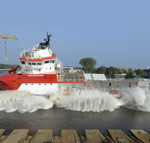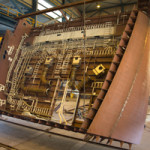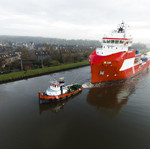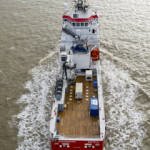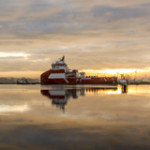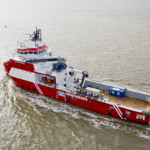Kroonborg: Royal Wagenborg’s Offshore Pioneer
Christened in February at the port of Delfzijl in the north of the Netherlands, Royal Wagenborg’s new offshore maintenance support vessel, Kroonborg, is set to provide maintenance and operations support for the North Sea offshore sector. Also known as the Walk-to-Work ship, the 79m vessel was designed to provide the offshore industry with multifunctional support – acting as hotel, workspace and storage facility. Furthermore, as the vessel will service several destinations en route, the number of helicopter flights required will be significantly reduced.
The Kroonborg concept was borne from Nederlandse Aardolie Maatschappij (NAM) and Shell UK awarding Royal Wagenborg a contract for a new type of vessel. Designed and completely built at Royal Niestern Sander shipyard in the Netherlands, the Kroonborg will support offshore operations transporting offshore maintenance and service crews to and from their workplace in the North Sea for an initial period of 10 years.
Oil & Gas Support
Many of NAM and Shell UK’s North Sea oil & gas platforms do not have a permanent crew or helicopter pad, which means frequent journeys to and from the platform by ship in order to perform maintenance work. The Kroonborg will play a crucial role maintaining and servicing NAM and Shell UK’s production platforms in the North Sea.
The Kroonborg will provide accommodation for up to 60 people, including 40 maintenance and service personnel. Service crews can work on 14-day shifts and the vessel is able to serve multiple offshore platforms on one route. Theo Klimp, Fleet Director of Royal Wagenborg, explains that the vessel will enable the vessel’s owners to execute work programmes on production platforms “more efficiently, safely and cost-effectively”.
NAM and Shell UK anticipate that the vessel, which will provide a workspace, floating hotel and a means of transport to and from offshore platforms, will deliver substantial cost savings.
Motion Compensation
Providing maintenance personnel living on the vessel access to fixed or floating offshore structures is a motion-compensated offshore gangway, the Ampelmann – from the Dutch company of the same name. This fully integrated access system will also be used to transfer small cargo and equipment. The Ampelmann consists of a self-stabilising hexapod with six hydraulic cylinders, which compensate the motion of waves up to 2.5m. The gangway has a maximum operational length of 22m.
Lifting operations to transfer equipment from the deck of the vessel onto a platform can be executed safely with a small and compact 3D-neutral crane – the Barge Master T40. With a 5t @ 20m or 15t @ 10m capacity, the crane compensates roll, pitch and heave motions with a system of five vertically mounted cylinders, which are placed between the vessel and the crane. Designed for minimum downtime in tough North Sea conditions, the Barge Master unit is capable of transferring equipment to and from a platform and the deck of the vessel in wave heights up to 2m.
“Active heave compensation is used on many cranes on offshore vessels, but the ability to compensate for pitching and rolling motions in addition to heave will be unique, at least in the offshore oil & gas sector,” highlights Mr Klimp. “Ensuring that the hook is stable in all directions really is new.”
Start Me Up
At the heart of the new design is a package of ‘cold start-up’(CSU) and intervention equipment installed in the vessel that will enable wells to be restarted more efficiently than is currently possible.
A special tank installation, containing six different chemicals, will be situated below deck. “The vessel will be certified to carry all of the usual chemicals an offshore vessel might transport, but it will also be able to transport very specialised chemicals used in interventions on a well,” Mr Klimp explains. “It will also have a dedicated area for all the pumps and frequency converters required to supply chemicals to a platform, and it will be certified for working with the very high pressures that a cold start up on a live well entails.”
Niestern Sander and Wagenborg turned to PG Marine for the CSU package, which will draw heavily on PG Marine’s experience with similar below-deck solutions for IMR vessels. The below-deck package will include pumping, injection and control systems, in addition to a nitrogen generator, umbilicals and hose-reels. Because the tanks are located below decks, the deck space measures 500m2 offering ample space for other maintenance equipment.
Predictive DP
Building a new design is always a question of combining the forces of designer and yard. In Kroonborg’s case, the Netherlands-based Conoship International supported Royal Niestern Sander with the design. They focused on determining the optimal main dimensions and hull form to minimise the impact on the environment. Designer and yard also teamed up to achieve the best seakeeping behaviour while meeting all stability requirements.
The Kroonborg’s hull design and dynamic positioning (DP) system produce a vessel that is unmatched in energy efficiency and makes considerable fuel savings possible. Designed to reduce fuel consumption, Kongsberg’s GreenDP secures the vessel, allowing it to stay within user-defined operational boundaries. This new approach is based on forecasting the vessel’s motion, rather than acting on present conditions, using a method called ‘nonlinear model predictive control’. This optimises the predicted vessel offset against the use of thrusters dramatically lowering peak loads. Studies have shown this minor sacrifice in station-keeping accuracy pays off with a fuel reduction of about 20 percent.
Owner Royal Wagenborg calls its new asset a clean and green vessel – something demonstrated further by the fact that by deploying the vessel reduces helicopter transfers by up to 600 flights a year, significantly reducing CO2 emissions. The company also has a strict ‘zero dumping philosophy’. Strengthening the green credentials even further is the fact that the Kroonborg as world’s first offshore vessel sails on GTL fuel, a liquid fuel made of natural gas: resulting in less emissions than conventional fuels for vessels.
By combining such sustainable principles with innovative design, Royal Wagenborg’s Kroonborg looks well set to crack on with the task at hand – executing safe and efficient offshore operations for NAM and Shell UK for the decade ahead.
Visit Royal Wagenborg at EWEA 2015 at stand C4-B54.







